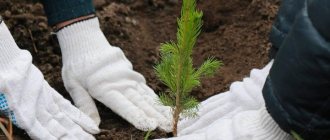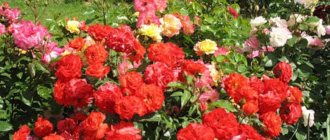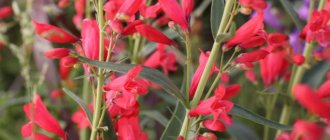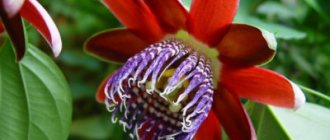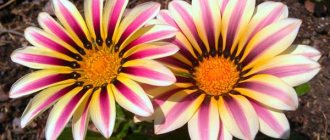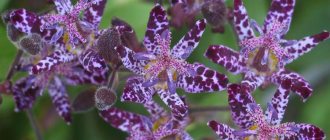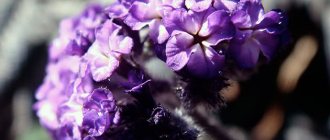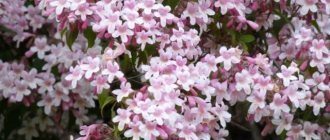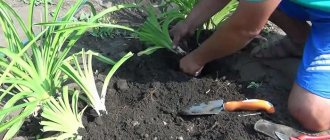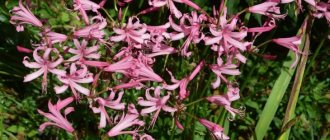Author: Natalya Category: Garden plants Published: February 27, 2019Republished: February 27, 2019Last edits: November 03, 2020
- When to plant
- Growing conditions
- How and when to collect seeds
- Meadow chamomile (Leucanthemum vulgare)
plant (lat. Matricaria) is a genus of herbaceous flowering perennials of the Compositae, or Asteraceae, family, uniting approximately twenty species of low aromatic herbs that bloom in the first year. In nature, daisies grow in Eurasia, both Americas, South Africa and Australia. It is curious that daisies also grew in Central Africa, but were destroyed by local tribes because they allegedly attracted evil spirits. The most famous species of the genus is chamomile, which has long been widely used for cosmetic and medicinal purposes. The Latin name of the genus is derived from the word translated as “uterus” - this is explained by the fact that chamomile was used in the treatment of gynecological diseases. Pliny the Elder described chamomile in his multi-volume Natural History under the name Chamaemellon, formed from two words meaning “low” (apparently, the short stature of chamomile was meant) and “apple” (the smell of chamomile was reminiscent of the aroma of apples). The Russian name of the plant comes from the Polish language and is derived from the word romana, which means “Roman”. Chamomile is often confused with plants of the Asteraceae family such as gerbera, aster, pyrethrum, chrysanthemum and cornflower, which is called garden chamomile. Actually, our story will be about garden chamomile, that is, about daisy, especially since planting and caring for daisies is no different from growing daisy, which for convenience we will call chamomile in the article.
Planting and caring for chamomile
- Planting: sowing seeds in the ground - at the end of May, sowing seeds for seedlings - in March, planting seedlings in the garden - in May.
- Flowering: from early July to September.
- Lighting: bright sunlight.
- Soil: slightly alkaline or neutral, in an area with deep groundwater.
- Watering: During the rooting period, seedlings are watered frequently, but then watering is required only during periods of prolonged drought.
- Top dressing: humus, peat and compost are added to the soil annually, and in mid-spring ammonium nitrate is scattered over the area at the rate of 20 g of fertilizer per m². There is no need to water the area after this.
- Reproduction: by seeds and dividing the bush.
- Pests: aphids, thrips, star flies and wireworms.
- Diseases: affected by powdery mildew, gray mold, rust and fusarium.
Read more about growing chamomile below.
Botanical description
Garden chamomile, or cornflower, or popovnik (lat. Leucanthemum vulgare), is a herbaceous plant from 15 to 60 cm in height with a short root, erect, slightly faceted stem, spatulate, crenate basal leaves on long petioles and oblong, irregularly serrated along the edges stem leaves, two of which, located in the upper part of the stem, are greatly reduced in size compared to the rest.
Chamomile flowers are hemispherical inflorescences-baskets with a diameter of 2.5 to 6 cm, united into corymbs. The baskets consist of central yellow tubular bisexual flowers and long marginal pseudolingulate sterile flowers, usually white, but sometimes yellow. The fruit of garden chamomile is an achene.
There are about two dozen species in the Nielberry genus.
- Oregano: cultivation, types and varieties
Growing chamomile from seeds
Sowing seedlings
Growing chamomile is possible in seedlings and without seedlings. You can sow garden chamomile seeds simply in the ground, but it is safer to use the seedling method.
Chamomile seeds are sown for seedlings in March. Trays with cells are filled with a moist, light, breathable substrate consisting of peat and sand in equal parts, 2-3 seeds are placed in each cell, sprinkled with a thin layer of substrate on top, the container is covered with a transparent film and placed close to the window, but not on window sill, since the light passing through the glass is too intense and can damage the seed germination process. Monitor the condition of the soil, and as soon as it dries, moisten it with a spray bottle.
How to sow seeds
When the seedlings begin to appear, and at normal room temperature this will happen in one and a half to two weeks, remove the film and place the container as close to a sunny window as possible, protecting the seedlings from drafts. If this is not possible for any reason, place a fluorescent lamp over the container, which should work for at least 14 hours a day. As soon as the chamomile seedlings reach a height of 5 cm, leave only one, the most developed seedling, in each cell.
Do not pull out unnecessary seedlings, but carefully pinch them off above the soil surface, because you risk damaging the root system of the remaining seedling. In order for chamomile to bush, pinch it over 3-4 leaves.
When and how to replant daisies
Perennial gypsophila: planting and care
How and when to replant large daisies is recommended by experienced flower growers.
If it is spring, then it is impossible to clearly indicate the timing of planting seedlings in open ground, since everything depends on the weather. Seedlings need to not only be grown strong, but also protected from cold and frost. When the seedlings have grown sufficiently and 4-5 true leaves have blossomed, they can be planted in open ground provided that the air temperature is + 15 °C or more.
Before planting chamomile seedlings in open ground, the soil is well dug up and fertilized with special preparations for flowering garden plants. After which the bushes need to be planted in groups of 2-3, at a distance of 30-40 cm.
Very often a situation arises where you need to quickly decide where and when it is best to plant perennial adult daisies. This happens when a plant is forced to be transplanted from a flower bed near the house due to construction work or the flower bed is moved to another place. Thanks to the peculiarities of the culture, the way out of this situation is quite simple - this flower is unpretentious and hardy, painlessly takes root in another place. Carefully enough, so as not to damage the roots, dig up the flowering plant with a lump of earth and move it to a new place, then water it generously.
Daisies
How to propagate garden chamomile
To propagate chamomile, they resort to simple traditional methods:
- seed (growing seedlings from seeds);
- vegetative (dividing the bush).
You can sow seeds both in spring and autumn directly in open ground, shoots will appear, but it is safer to grow seedlings. In March, the seeds are sown in a special soil mixture of peat, garden soil, sand (1:1:1). To avoid washing the seeds out of the soil, water them carefully, then, to create a greenhouse effect, cover the container with film and place it in a dark, warm place. To avoid drying out the soil, it is constantly sprayed with water. As soon as the first shoots appear (usually this happens after 10-12 days), the film is removed and the boxes are transferred to a sunny place.
Chamomile can also reproduce by dividing the bush. Despite the ability of chamomile to grow in the same place for several years, it should be renewed periodically (every 4-5 years). New planting material is being prepared in September. An adult bush is completely dug out of the ground, after which younger root shoots are selected from it for planting.
Planting chamomile in open ground
When to plant
Seedlings are planted in the ground at the age of 4-6 weeks, when all possible frosts have passed. Garden chamomile loves sunny areas with calcareous or neutral soil and deep groundwater.
How to plant
Planting daisies in the ground is carried out after preparing the site - complex fertilizer for flowers must be added to the soil for digging. Dig holes 20-30 cm deep at a distance of 20 to 40 cm from each other - the distance between the bushes and the depth of the holes depend on the chamomile variety. Remove the seedlings from the cells along with the earthen ball, plant them in the holes, press the soil around the stems and water the seedlings. Chamomiles from seeds will bloom next year.
Reproduction of garden chamomile by dividing the bush
Chamomiles planted on the site grow well, form clumps, which remain decorative even outside of flowering and resemble green pillows. However, after a few years, the perennial needs rejuvenation, otherwise the inflorescences become smaller every year, the foliage becomes smaller and weaker.
Perennial garden daisies reproduce by seed and vegetative methods. If these beautiful flowers are already growing in the flower beds, it is enough to divide the adult curtain into several.
It is best to plant a perennial in the first half of autumn, dividing the plant into parts so that each has a part of a strong rhizome and several growing points. The soil for planting chamomile must be dug up, cleared of weeds and moistened:
- The hole is dug a little larger than the root system.
- The plant in the planting hole is placed at the same level, after straightening the rhizomes.
- The hole is filled with soil, which is compacted and watered.
Since seeds from faded baskets do not convey the characteristics of the parent plants, vegetative propagation is indispensable if you want to get young clumps of any varietal garden chamomile.
The more often the clumps are rejuvenated, the more spectacular their flowering and the larger the inflorescences. However, spring replanting may delay or cancel the appearance of buds.
Caring for daisies in the garden
Growing conditions
Until the chamomile seedlings become comfortable in the soil and begin to grow, they need to be watered frequently, but after rooting, the flowers require watering only in dry weather. To keep moisture in the soil longer, mulch the surface around the plant with peat. Otherwise, caring for daisies consists of loosening the soil, weeding the area, fertilizing and preparing perennial plants for winter.
Humus, peat and compost are added to the soil annually as fertilizers. In mid-spring, ammonium nitrate is scattered between the rows at the rate of 20 g per m² without subsequent watering. During the budding period, it is advisable to apply a urea solution to plants with faded stems and leaves. Slaked lime or dolomite flour is added to acidic soil in the fall.
Chamomile propagation
Garden daisies are propagated by dividing the bush and by seed. Despite the fact that perennial daisies can grow in one place for five years, after 2-3 years the bushes become too dense, shoots die off in the middle of the bush, the size of the inflorescences decreases, and the plant loses its attractiveness. This can be avoided by promptly planting young, strong shoots from the bush. At the end of September or beginning of October, on a cloudy, cool day, separate a part from the bush and plant it in a prepared hole, spilled with settled water, and fill the resulting void with fertile soil.
Next time, dig up and replant part of the bush on the opposite side. This is how varietal and double daisies are propagated. If you want to achieve the largest flowers on powerful stems, you need to divide your daisy bushes annually.
Garden daisies also reproduce by seeds. We have described growing chamomile seedlings to you, but you can sow the seeds directly into the ground before winter. In cold soil they will undergo natural stratification and germinate together in the spring, and all you have to do is thin out the seedlings.
Pests and diseases
With insufficient or irregular care, chamomiles have a chance of developing powdery mildew, gray mold, rust and fusarium.
Powdery mildew appears as a whitish coating on the above-ground parts of the plant, which gradually turns brown.
- Campsis: planting and care, propagation, types and varieties
Rust appears as dark red spots on the upper side of the leaves, and on the lower side it forms pads with fungal spores.
Fusarium is also a fungal disease, in which the roots and root collar of young plants begin to rot, the tissues become brown, the stem becomes thinner, and the leaves turn yellow.
Gray rot is manifested by rapidly increasing in size brown necrotic spots on shoots and leaves. At high air humidity, the spots are covered with gray mycelium fluff.
To prevent fungal infection of flowers, do not allow excess moisture in the soil, promptly remove weeds and loosen the soil. It is better to immediately remove a specimen infected with gray rot so that the disease does not spread to neighboring plants.
They destroy fungal microflora with fungicides - Fundazol, Topaz, Kuproxat, Oksikhom and other drugs of similar action. Treatment is carried out two or three times with an interval of 7-10 days.
Among the pests, garden chamomile is affected by aphids, thrips, star-winged flies and wireworms.
The star-winged fly is so named because of the small star-shaped spot on its wing. Its larvae damage garden chamomile, accumulating at the base of the middle flowers. You can protect the planting of daisies from the appearance of this pest by regularly destroying weeds on the site.
Thrips and aphids are sucking insects that feed on the cell sap of the above-ground parts of the plant. Discolored or yellow spots, streaks and stripes appear on the leaves, damaged tissues die, leaves wither, fall off, flowers become deformed and lose their decorative effect. In the fight against aphids and thrips, insectoacaricides are used - Karbofos, Agravertin or Actellik.
Wireworms are the larvae of click beetles. They live in the soil for up to four years and feed on underground parts of plants. To get rid of them, traps are set in the soil: holes are dug into which pieces of potatoes, carrots or beets are placed. The top of the trap is covered with a board or piece of metal. After 2-3 days, the traps are opened and the wireworms that have accumulated in them are destroyed. This needs to be done regularly. Most often, wireworms appear if there is a plot of potatoes nearby.
Pests and treatment of chamomile
Chamomiles, like other herbaceous plants, are susceptible to fungal diseases. They especially spread when the soil is waterlogged. Therefore, there is no need to flood the chamomile plantings too much.
Rust and powdery mildew often cause poor plant development. For prevention or at the first signs of disease, spray chamomile with a 1% solution of Bordeaux mixture. Spray regularly, after about 10 days, 4-5 times. After this, sprinkle the plants with ash.
If you cannot get rid of the disease, it is better to remove the diseased plants and burn them.
Snails and slugs love to feast on the succulent leaves of chamomile. Spraying chamomile bushes with a weak solution of coffee, pepper or mustard helps get rid of them.
Perennial daisies after flowering
How and when to collect seeds
If you want to collect seeds, wait for several large flowers to dry, and only then cut them off, dry them in a dry room with good ventilation and remove the seeds from the middle tubular flowers onto paper. They will need to be winnowed, poured into a paper bag and stored in a dry, dark place. Nielberry seeds remain viable for 2-3 years. However, remember that when propagated by seed, varietal and double daisies do not inherit the characteristics of their parents.
Preparing for winter
Planting and caring for perennial daisies is no different from growing annual daisies, except for one thing - they need to be covered for the winter. Before the onset of cold weather, the stems of perennial garden daisies are cut off at surface level, after which the area is covered with dry leaves, sawdust or covered with non-woven material.
Chamomile propagation
The most common method of plant propagation is propagation by seeds. The seeds are collected after several large inflorescences have faded and completely dried out. They should be cut and placed to dry in a dry, well-ventilated area.
When the inflorescences are completely dry, you need to remove the seeds from the middle flowers and place them on a piece of paper. After this, the seeds must be sifted and excess husks and flower remains removed. Seeds should be stored in paper bags at room temperature in a shaded and dry place. Under such conditions, seed germination is maintained for three years. Planting a plant with seeds was described earlier.
Obtaining plant seeds
Less common is chamomile propagation by dividing the bush. Usually, it is carried out either simultaneously with the rejuvenation of the plant, or somewhat more often (every 2-3 years). In the first case, the bush is simply divided into two identical parts directly in the ground using a shovel, and half of it is dug up and transplanted to a new place.
If a more controlled division of the plant is required, then the chamomile bush is dug up completely . It is inspected, weak or diseased parts of the root system are rejected, and young and strong shoots are separated from the main bush. They are planted in a new location in pre-prepared holes, which should be pre-moistened and humus, peat or compost added to them.
This procedure is recommended to be done in September. It is advisable to do this in cloudy and cool weather in the evening.
Some gardeners recommend dividing the bush annually . In the winter, the chamomile shoots will still be cut off, so the bush will in any case re-form its vegetative part, and thinned bushes have a higher growth rate. The main thing is not to forget about autumn and spring feeding.
Types and varieties
In addition to the common cornflower, or meadow chamomile, there are other types of cornflower that are grown in cultivation.
Meadow chamomile (Leucanthemum vulgare)
Or common cornflower, grows in Western Europe, Ukraine, the European part of Russia, and southern Siberia. This is a perennial up to 90 cm high with single inflorescences-baskets with a diameter of 6-7 cm with white reed flowers and yellow tubular ones. The species has been in cultivation since 1500. The best garden forms of the species are:
- Sans Souci is a cornflower up to 1 m high with inflorescences up to 12 cm in diameter. White reed flowers are arranged in 6-8 rows, the few middle flowers are yellow;
- May Queen is a traditional chamomile, very popular in amateur gardens, up to 50 cm high with bright, shiny dark green leaves forming the ground cover;
- Maxima Koenig is a plant up to 1 m high with inflorescences up to 12 cm in diameter with dark yellow middle flowers and two rows of white reed flowers.
Kuril cornflower (Leucanthemum kurilense)
A late-blooming rock daisy with dissected leaves, growing in the Kuril Islands and on the Japanese island of Hokkaido. The rhizome of this species is fleshy and thickened. The plant reaches only 20 cm in height, while its few single baskets have a diameter of 5 to 8 cm. The marginal flowers are white. The Kuril cornflower has a variety called arcticum, which differs in the shape of its leaves.
- Red clover: cultivation, properties, varieties
Swamp cornflower (Leucanthemum paludosum)
It is also known as the marsh chrysanthemum (Chrysanthemum paludosum) native to the south of Portugal and Spain. This is a low-growing, but very bushy plant up to 25 cm high with sessile spatulate alternate leaves of bright green color and crenate along the edge. Inflorescences are numerous baskets up to 3 cm in diameter with short reed flowers of white color and a large yellow center of tubular flowers.
Leucanthemum maximum
In nature, it grows in the Pyrenees and is a perennial with a height of 50 to 100 cm with a short ground rhizome, spatulate sessile leaves with a crenate edge and inflorescences-baskets with a diameter of 10-12 cm. In simple inflorescences, the marginal white flowers are arranged in two rows, the middle ones, tubular yellow. Double inflorescences consist of numerous rows of white reed flowers, and the tubular ones also have a white corolla. The double inflorescences of this type of nevus are very similar to chrysanthemums. Nielberry is grown as a maximum biennial plant. The species has been in culture since 1816. The best varieties:
- Alaska - a variety with baskets up to 10 cm in diameter with one row of white reed flowers;
- Beethoven - lushly blooming daisies with simple inflorescences up to half a meter high;
- Stern von Antwerp is a variety up to 1 m high with inflorescences up to 10 cm in diameter. Reed flowers are white, tubular flowers are yellow;
- Schwabengrub - a variety up to 80 cm high with snow-white double inflorescences;
- Little Princess is an elegant chamomile up to 20 cm high with large bright white inflorescences.
In addition to cornflower, other flowers of the Asteraceae family are also grown as garden chamomile - matricaria, pyrethrum, navels, erigeron and odorless chamomile.
Types of chamomile with photos and descriptions
In Europe, people began growing chamomile in their gardens about 500 years ago. During this time, many different varieties were bred: with abundant and rather long flowering and large inflorescences. It was even possible to breed chamomile with terry forms.
Below are the types of chamomile, their names and photos.
Cornflower (Chrysanthemum leucanthemum)
It is classified as a classic chamomile, having a yellow core and white petals . Among the people, it received such names as golden flower, popovnik, milky chrysanthemum and gigantic chamomile.
As a cultivated plant in gardens, the most common type of garden chamomile is the common cornflower. Its height can reach 60-70 cm, and the inflorescences have a diameter of 6-7 cm. Nielberry flowering continues for 2 months, starting from the first days of June.
There are more than 10 varieties, which vary in shape, petal structure and flower size.
- Crazy Daisy - has double lush flowers reaching a diameter of 10 cm. The height of the chamomile reaches 90 cm. Flowering begins in July.
- “Snow Lady” - its main difference is its snow-white color, flower diameter is 17 cm. Unfortunately, this variety does not tolerate winter and frost, for this reason it is often grown as an annual plant.
- “Wirral supreme” - this variety of nevus reaches a length of 90 cm. Flowering begins in July and continues until September. The inflorescences are white, double, and have a yellow core. This plant tolerates winter well and is easy to care for.
- Real Neat - the bush grows up to 45 cm in length, the flowers have unusual tubular white petals that bifurcate at the ends, thereby creating a grooved edge. During the flowering period it looks very original and impressive.
Pyrethrum (Pyrethrum roseum Adam)
The flowers of this species are small in size and have a wide range of colors - white flowers, pink, scarlet, crimson, red.
This type of chamomile differs from the previous one in the structure of its leaves, which have a fern-like shape. The most popular varieties of pyrethrum include:
- Robinson is a tall plant (reaching a length of 80 cm) with large pink flowers with a diameter of 12 cm. Flowering begins in mid-June and continues throughout the month. This variety is winter-resistant and also shade-tolerant.
- Paradise - its main difference is its slightly corrugated petals, the color changes from white and pink to a crimson hue.
- Hybrid “Terry pink” - its length reaches 50 cm, flowers with a diameter of 5-6 cm, pink-raspberry color, densely double.
Pyrethrum parthenifolium aureum
This species looks wonderful along borders, and it is very easy to recognize by the color of its leaves, because they have a sunny yellow color. Breeders have developed several varieties of pyrethrum that will undoubtedly decorate your garden.
- “Golden Ball” - has small-sized (3-4 cm) double yellow flowers of a spherical shape. This is a low-growing plant, reaching a length of 20-25 cm, but it looks charming in the edging of flower beds or along borders.
- "Carlos" is also a low-growing plant, it has white flowers with a pleasant aroma. The lower petals are slightly longer than the others, and create a “skirt” frame.
- "Snow Globe" - distinguished by whiter, larger and spherical flowers.
Doronicum
It is an early flowering plant, has yellow inflorescences that are pleasing to the eye from the beginning of May to the end of June. Their genus includes about 36 species, but in gardening the most popular are only three species:
- Doronicum Caucasian - reaches a length of 50 cm, has large flowers. It has a dark yellow head and an orange disc.
- Doronicum travelum - its distinguishing features are a long peduncle reaching up to 140 cm and large yellow inflorescences, approximately 12 cm in size. Flowering begins in mid-May and continues for a month. However, this variety has one drawback - it very quickly loses its decorative properties, because the leaves gradually die off at the end of June.
- Doronicum orientalis is a shade-tolerant plant, has an erect stem 30-50 cm long, at the top of which large yellow flowers bloom (about 8 cm in diameter). It begins to bloom in mid-May and continues until mid-June. However, this variety, like the previous one, very quickly loses its decorative qualities due to the rapid death of leaves. For this reason, experienced gardeners recommend planting these varieties in the background.
Antemis (Athemis tinctoria)
Another name for this species is dyeing navel. The flowers of this type of chamomile have a rich yellow color and reach 5 cm in diameter. The length of the plant is approximately 30 cm. It is distinguished by good branching and pubescent grayish-green leaves.
Antemis tolerates heat and heat very well. Chamomile blooms profusely and for a long time, beginning to bloom in mid-July. Reproduction occurs by self-sowing.
Big daisies
Many people wonder what large daisies are called? The name of such a chamomile is autumn or late chrysanthemum . This bush chamomile is extremely popular, due to its unpretentiousness in care and maintenance. Also, many people are attracted by the spectacular appearance of huge flowers, the length of which can reach human height (approximately 130-160 cm).
For the most part, the flowers of this type of daisy reach approximately the same height. Therefore, it may seem as if the flowers are collected in beautiful huge bouquets.
Flowering time begins at the end of August and continues until the end of November. Snow can often be seen on the last flowers.
The following varieties of large chamomile are distinguished:
- Princess. This variety is quite short in length and blooms in early July before frost. The princess will grow well if she is provided with regular and abundant watering.
- Alaska. This is a large garden perennial chamomile, characterized by large flowers and a long stem. Flowering begins at the very beginning of the summer season and lasts until its end.
- Osteospermum. This variety is also called African chamomile, which has an unusually beautiful appearance. The birthplace of the flower is South Africa, which explains the name of the plant. It is easy to care for.
Colored daisies
Often many flowers and plants are incredibly similar to each other, and distinguishing one flower from another is not an easy task. Such plants are flowers similar to chamomile. In this regard, many people wonder what colored daisies are called. Such “daisies” can be:
- daisies;
- calendula;
- helichrysum;
- wendidum;
- arctotis;
- Gatsaniya.
